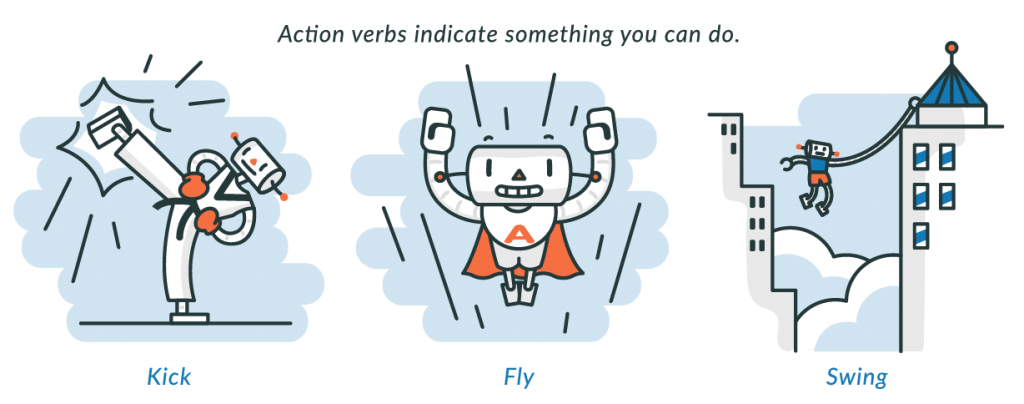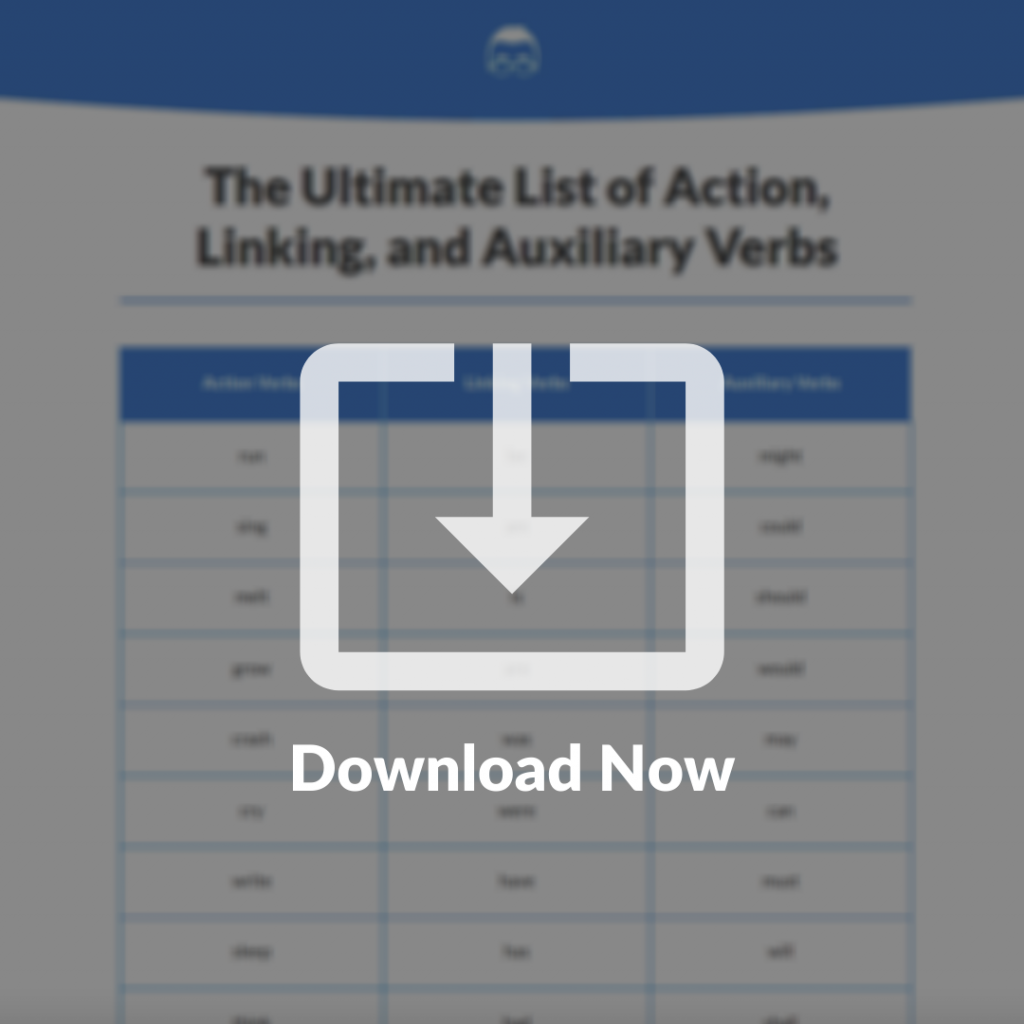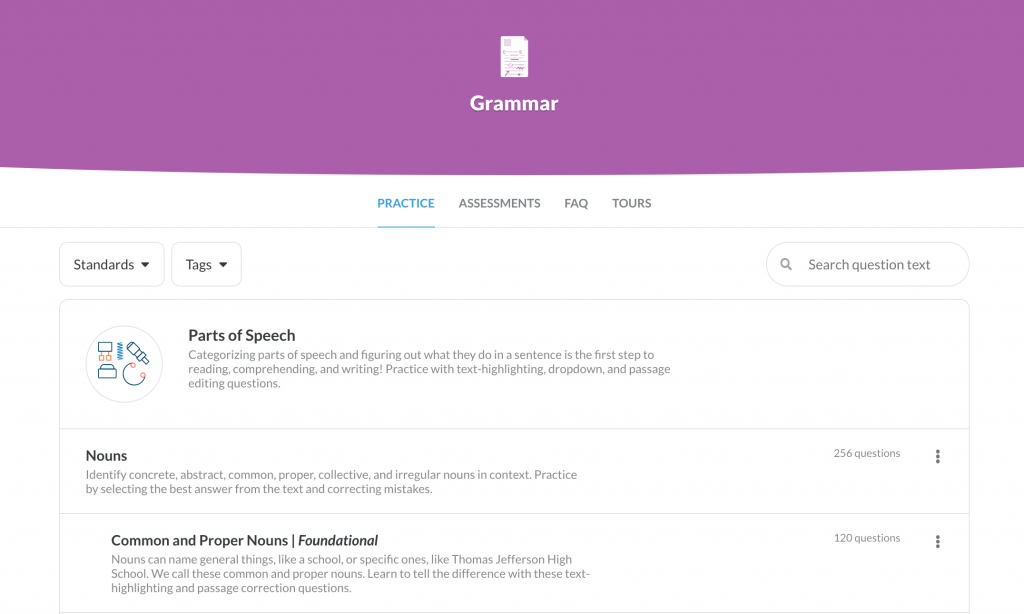What is an Action Verb?
An action verb is a word that describes… an action! When something happens in a sentence, the action verb is the word that expresses that action.
For example, the words eat and jump are action verbs. They tell you exactly what happened.
You probably use action verbs all the time without realizing it because they’re one of the basic building blocks of communication in English.
Simple Action Verb Flashcards For K-2
Can you sing? Do you eat breakfast? Check out these action verb flashcards with simple images. To move to the next slide click </>.
Types Of Verbs for 3-5+
Compare these verbs, and see if you can identify how they’re different:
Action Verb
- to finish, to accept, to finish, to leap, to fix, to sing
Stative Verb
- to have, to belong, to like, to love, to hate, to resemble
Linking Verb
- to be, to become, to appear
As you can see from these lists, action verbs have a lot more energy than stative or linking verbs. This makes them essential for good writing.
Whether you’re writing essays, newspaper articles, resumes, or client reports, action verbs bring your ideas to life. In a history paper, action verbs will make your text much more exciting to read. And on your resume, action verbs will highlight all of the hard work you’ve been doing.
Importance of Action Verbs
There are several other types of verbs in English, but these don’t pack as much of a punch in writing. For example, there are stative and linking verbs.
Stative verbs, as the name suggests, report a state of being, rather than something that is actually happening. On the other hand, a linking verb simply connects the subject and the complement that describes the subject of the sentence.
Action Verb Tenses
Action verbs are a little different than stative and linking verbs because you can use action verbs in any tense. (Stative and linking verbs are more limited)
So, past, present, and future are all okay!
Here are some examples:
To Eat
- I eat, I ate, I will eat
- I am eating, I was eating, I will be eating
- I have eaten
- I will have eaten
To Go
- you go, you went, you will go
- you are going; you were going, you will be going
- you have gone
- you will have gone
To Walk
- they walk, they walked, they will walk
- they are walking, and they were walking, they will be walking
- they have walked
Action Verb Examples
Everything you do, every single day, is an action verb! Here are some common action verbs you might come across.
Everyday Action Verbs
Here are some everyday action verbs, you may have seen some of them before!
Physical
- to walk, to jog, to run
- to skip, to jump, to hop
- to stop, to go
- to laugh, to cry, to scream
- to eat, to gorge
- to clean, to sweep, to wash
- to punch, to kick, to bruise
- to slice, to chop, to cut
- to sleep, to nap, to toss and turn, to wake
- to study, to write, to erase, to blot
- to draw, to paint, to sculpt
- to play, to climb, to build, to race
- to take, to give
- to smile, to frown, to sigh
- to whistle, to sing, to hum
- to trip, to fall, to stumble
- to call, to text, to phone
- to travel, to visit, to explore
Mental
- to think, to ponder, to wonder
- to hope, to dream, to imagine
- to plan, to organize, to envision
- to remember, to forget
- to guess, to estimate, to predict
- to hesitate, to consider, to dither, to waver
Provoking Emotion
- to astonish, to amaze
- to please, to impress
- to surprise, to scare, to startle
- to bother, to annoy
- to worry, to concern
Action Verbs for School
You can quickly explain exactly what you did at school with just a word or two. So, take a look at these verbs to help you describe the work you’ve been doing and show off how good you are at school!
Leadership
- to supervise, to lead, to manage
- to monitor, to inspect
- to oversee, to spearhead
- to chair, to head, to direct
- to coordinate, to organize, to facilitate
- to authorize, to verify, to enforce
Creation
- to create, to plan, to produce
- to develop, to design
- to found, to form
- to institute, to pioneer
- to propose, to build
Improvement
- to improve, to advance, to move forward
- to expand, to enhance, to increase
- to stimulate, to energize
- to revitalize, to restore,
- to modernize, to digitize
- to standardize, to maximize
- to gain, to promote
- to redesign, to overhaul
- to revamp, to rehabilitate
- to streamline, to optimize, to refine, to simplify
- to strengthen, to clarify
- to restructure, to remodel
Support
- to support, to motivate
- to train, to mentor, to teach
- to cultivate, to foster
- to recruit, to train
- to unify, to mobilize, to enable
Research
- to research, to analyze
- to evaluate, to examine
- to qualify, to quantify
- to compile, to interview, to interpret
- to discover, to explore
- to project, to forecast, to model
Communication
- to write, to author, to draft
- to document, to outline
- to edit, to critique, to review
- to pitch, to sell
- to acquire, to close
- to campaign, to convince, to lobby, to persuade
- to publicize, to present, to promote
- to partner, to negotiate
- to forge, to secure
Accomplishing Goals
- to accomplish, to win, to finish, to attain
- to overcome, to succeed,
- to surpass, to exceed
- to earn, to reach
- to demonstrate, to complete
Conclusion
Action verbs are a very easy concept to grasp, but using them in your writing has huge implications. Action verbs are much more exciting than stative or linking verbs, so people will engage better with what you have to say.
So, add passion to your writing with more action verbs!
And for more great grammar resources, check out the other articles on this page. There are many useful tips and tricks for jazzing up your writing!
Want more resources for elementary students? Check out the links below.
What is a verb?
Verbs are the action words in a sentence that describe what the subject is doing. Along with nouns, verbs are the main part of a sentence or phrase, telling a story about what is taking place. In fact, without a verb, full thoughts can’t be properly conveyed, and even the simplest sentences, such as Maria sings, have one. Actually, a verb can be a sentence by itself, with the subject, in most case you, implied, such as, Sing! and Drive!
When learning the rules of grammar, schoolchildren are often taught that verbs are ‘doing’ words, meaning they signify the part of the sentence which explains the action taking place: He ran away, she eats chocolate cake on Sundays, the horses gallop across the fields. Ran, eats and gallop are the ‘action’ parts of those sentences, thus they are the verbs. However, it can be confusing because not all verbs are easily identifiable as action: I know your name, Jack thought about it, we considered several applications. These are non-action verbs, i.e. those that describe a state of being, emotion, possession, sense or opinion. Other non-action verbs include include love, agree, feel, am, and have.
How to Recognize a Verb
As you can see from the examples above, one clue to help you recognize a verb is its location compared to the subject. Verbs almost always come after a noun or pronoun. These nouns and pronouns are referred to as the subject. The verb thought comes after the noun Jack, so the action Jack (subject) was taking was thinking (verb).
- Mark eats his dinner quickly.
- We went to the market.
- You write neatly in your notebook.
- They thought about all the prizes in the competition.
Here are some other ways to recognize verbs in a sentence:
- If you’re not sure if a word is a verb, ask yourself, “Can I do ______?”
Can I think, wonder, walk, yawn? Yes, so these are verbs.
- You can also ask, ”What is happening?”
In the sentence Mark eats his dinner quickly, what is happening? Eating is happening, so eating is the verb.
In the sentence They thought about all the prizes what is happening? Thought (thinking) is happening, so thought is the verb.
Physical Verbs – Definition and Examples
Physical verbs are action verbs. They describe specific physical actions. If you can create a motion with your body or use a tool to complete an action, the word you use to describe it is most likely a physical verb. For example, Joe sat in his chair, the dog breathes quickly after she chases her ball, and should we vote in the election? Even when the action isn’t very active, if the action is done by the body or a tool, consider it a physical verb.
Physical Verb Examples
The physical verb examples in the following sentences are in bold for easy identification.
- Let’s run to the corner and back.
- I hear the train coming.
- Call me when you’re finished with class.
Mental Verbs – Definition and Examples
Mental verbs have meanings that are related to concepts such as discovering, understanding, thinking, or planning. In general, a mental verb refers to a cognitive state.
Mental Verb – Definition and Examples
Mental verbs have meanings that are related to concepts such as discovering, understanding, thinking, or planning. In general, a mental verb refers to a cognitive state.
Mental Verb Examples
The mental verb examples in the following sentences are in bold for easy identification.
- I know the answer.
- She recognized me from across the room.
- Do you believe everything people tell you?
States of Being Verbs – Definition and Examples
Also known as linking verbs, state of being verbs describe conditions or situations that exist. State of being verbs are inactive since no action is being performed. These verbs, forms of to be, such as am, is, are, are usually complemented by adjectives.
States of Being Verb Examples
The state of being verbs in the following sentences are in bold for easy identification.
- I am a student.
- We are circus performers.
- Please is quiet.
Types of Verbs
There are many types of verbs. In addition to the main categories of physical verbs, mental verbs, and state of being verbs, there are several other types of verbs. In fact, there are more than ten different types of verbs that are grouped together by function.
List of all Verb Types
Action Verbs
Action verbs express specific actions and are used any time you want to show action or discuss someone doing something. It’s important to remember that the action does not have to be physical.
Action verb examples:
- Run
- Dance
- Slide
- Jump
- Think
- Do
- Go
- Stand
- Smile
- Listen.
The action verb examples in the following sentences are in bold for easy identification.
I run faster than David.
He does it well.
She thinks about poetry all day long
Transitive Verbs
Transitive verbs are action verbs that always express doable activities that relate or affect someone or something else. These other things are generally direct objects, nouns or pronouns that are affected by the verb, though some verbs can also take an indirect object, such as show, take, and make. In a sentence with a transitive verb, someone or something receives the action of the verb.
Transitive verb examples:
- Love
- Respect
- Tolerate
- Believe
- Maintain.
The transitive verb examples in the following sentences are in bold for easy identification.
Gary ate the cookies.
The transitive verb is ate, Gary is the subject, because it is Gary who is doing the eating, and the cookies are the direct object, because it is the cookies that are being eaten. Other examples:
He kicked John.
John punches him.
They sold the tickets.
Examples of verbs used with both direct and indirect objects:
They sell him the tickets.
In this sentence, the tickets are the direct object while him is the indirect object.
Mary baked her mother a pie.
In this sentence, a pie is the direct object while her mother is the indirect object.
Intransitive Verbs
Intransitive verbs are action verbs that always express doable activities. They are different from transitive verbs because there is no direct object following an intransitive verb.
Intransitive verb examples:
- Walk
- Laugh
- Cough
- Play
- Run
The intransitive verb examples in the following sentences are in bold for easy identification.
We travelled to London.
The intransitive verb is travelled, the subject is we, because we are doing the travelling, but London is not a direct object because London is not receiving the action of the verb. Other examples:
I sneeze in the morning.
He arrived with moments to spare.
Kathryn sat away from the others.
John eats before leaving for school.
The last example shows that the verb eats can be both transitive and intransitive depending on whether there is a direct object or not. If the sentence read: John eats the cookies before leaving for school, eats would be transitive as there is a direct object – the cookies.
By the way, some verbs can be both transitive and intransitive. These verbs include: start, leave, change, live, stop.
Auxiliary Verbs
Auxiliary verbs are also known as helping verbs and are used together with a main verb to show the verb’s tense or to form a question or negative. Common examples of auxiliary verbs include have, might, will. These auxiliary verbs give some context to the main verb, for example, letting the reader know when the action took place.
Auxiliary verb examples:
- Would
- Should
- Do
- Can
- Did
- Could
- May
The auxiliary verb examples in the following sentences are in bold for easy identification.
I will go home after football practice.
The auxiliary verb will is telling us that the action of the main verb go is going to take place in the future – after football practice has ended. If the auxiliary verb will was removed, we get the sentence:
I go home after football practice.
In this case, there is no definite time frame for the action. The sentence suggests that going home after football practice is just something the subject I generally does. Other examples:
I may dance with you later.
We did consider Bryan’s feelings.
Jenny has spoken her final words.
In addition, we can sometimes use the auxiliary very before the pronoun to make a question:
Might you dance with me later?
Did we consider Bryan’s feelings?
Has Jenny spoken her final words?
Also, auxiliary verbs are used to help form negative statements, with the use of words like not and never. These will usually split the auxiliary and main verbs:
I may never dance with you again.
We did not consider Bryan’s feelings.
Jenny has not spoken her final words.
Stative Verbs
Stative verbs can be recognized because they express a state rather than an action. They typically relate to thoughts, emotions, relationships, senses, states of being, and measurements. The best way to think about stative verbs is that they are verbs that describe things that are not actions. The stative verbs are all expressing a state: A state of doubting, a state of believing, a state of wanting. These states of being are often temporary.
The stative verb examples in the following sentences are in bold for easy identification.
The doctor disagrees with your analysis.
Disagree is a stative verb here, as it describes the doctor’s state of being – disagreement.
John doubts the doctor’s opinion.
I believe the doctor is right.
She wanted another opinion.
Modal Verbs
Modal verbs are auxiliary verbs that are used to express abilities, possibilities, permissions, and obligations.
Modal verb examples:
- Can
- Must
- May
- Should
- Would
The modal verb examples in the following sentences are in bold for easy identification.
He can shoot a three-point shot easily.
The auxiliary verb can is expressing an ability, suggesting that shooting a three-point shot is a skill the subject possesses.
Please note that in the case of should and must in the examples below, the modal verbs are expressing obligations, whereas would and may are expressing possibilities.
I should go home.
You must not delay.
Sally would not recommend the sushi.
David may be late.
Phrasal Verbs
Phrasal verbs aren’t single words; instead, they are combinations of words that are used together to take on a different meaning to that of the original verb. There are many examples of phrasal verbs, some of which have colloquial meanings, such as make up, hand in, bring up, point out, look forward to. Each time the verb takes the extra word(s) it takes on a new meaning. For example, make without the up expresses that something is being created, whereas with make up, the suggestion is that there are some lies or a fantastical element to the story and make out can mean either to grasp or see something difficult, or to kiss passionately.
Phrasal verb examples:
- Run out
- Go all out
- Make out
- Hand out
- Bring out
- Face up
- Think through
The phrasal verb examples in the following sentences are in bold for easy identification.
Mary looked forward to her high school reunion.
The verb looked has taken on forward to to become a phrasal verb meaning to be excited about or eagerly await something.
He brought up the same points again and again.
Leroy handed in the wallet to the police.
I make up stories all the time.
She pointed out Donald’s mistake.
Irregular Verbs
Irregular verbs are those that don’t take on the regular spelling patterns of past simple and past participle verbs. Unfortunately, there are hundreds of irregular verbs in the English language. But don’t worry, while many are used often, the majority are not in common usage – or if they are, you will use them so often you will learn them quickly. Some of the most common irregular verbs include: say, make, go, take, come, know and see.
Irregular verb examples:
- Eat
- Think
- Bring
- Hold
- Bear
- Buy
- Lay
- Catch
- Drive
- Paid
- Feel
- Redo
The irregular verb examples in the following sentences are in bold for easy identification.
I take my time when I go to the shops (present tense)
I took my time when I went to the shops (past tense)
Julie makes cake for the classroom (present tense)
Julie made a cake for the classroom (past tense)
She sees a silhouette shaped like a man in the window (present tense)
She saw a silhouette shaped like a man in the window (past tense)
We come to Aunt Jane’s for Thanksgiving each year (present tense)
We came to Aunt Jane’s for Thanksgiving each year (past tense).
You should also remember that auxiliary verbs ‘do’ and ‘have’ are also irregular verbs:
I do agree.
He does it often.
We have done our homework early.
They do their homework on Fridays.
I have a suspicion about Fran
Fran has a devious look.
We have no money left.
They have had a cough twice this winter.
Action verb definition: An action verb is a verb that a subject can complete.
What does action verb mean? An action verb is type of verb. An action verb is a verb that the subject can do.
If a subject can DO the action, it is an action verb.
Action verbs can be in any verb tense.
Action Verb Examples in Sentences
- He works
- They made
- We responded
- I thought about my response.
Common Action Verbs
to do
- to make
- to walk
- to have
- to eat
- to say
In all of these example action verbs, the subject can do them.
Transitive, Intransitive Verbs are Action Verbs

Transitive verbs “transfer” the action to an object. That is, the subject does something to someone or something else through a transitive verb. Transitive verbs will answer the question “to what?” or “to whom?”
Examples of Transitive Verbs:
- Fred hit Ginger. (Fred hit whom? Ginger.)
- Sarah answered the question. (Sarah answered what? The question.)
Intransitive verbs do not transfer action and will not have direct objects. Intransitive verbs will not answer the question “to what?” or “to whom?”
Examples of Intransitive Verbs:
- The plane landed at the airport.
- “At the airport” does not answer “what?” or “whom?”.
- “landed” is an intransitive verb.
- We swam in the pool.
- “in the pool” does not answer “what?” or “whom?”.
- “swam” is an intransitive verb.
Both transitive and intransitive verbs are action verbs, however. In each example sentence above, the subject is DOING something.
Action vs. Non-action Verbs

Common Non-action Verbs Include:
- to be
- sensory verbs: to look, to smell, to taste, to sound
- to believe
- to consider
- to posses
- to prefer
- to like
- to want
- to need
- to own
Examples in Sentences:
- I own the house.
- She considers her answer.
- We need a new car.
As you can see, there is not action taking place in these sentences. Rather, they are more descriptions of reality, a state of being, a preference, etc.
Action Verbs and Progressive Tenses

Non-action verbs cannot be used in the progressive tense. This is because the progressive tense itself is used for ongoing action. Only an action verb can be used in the progressive tense.
Examples:
- Incorrect: He is wanting dinner.
- Incorrect: They are seeming friendly.
- Incorrect: She is needing a new phone.
Rather, non-action verbs use the simple present tense.
- Correct: He wants dinner.
- Correct: They seem friendly.
- Correct: She needs a new phone.
Summary: What are Action Verbs?
Define action verb: The definition of action verb is a verb that expresses the action of the subject; a verb that does something and the subject can complete.
In summary,
- Action verbs are any verb that a subject can do.
- Action verbs can be transitive or intransitive verbs.
- Additionally, only action verbs (not non-action verbs) can be used in the progressive tenses.
Contents
- 1 What is an Action Verb?
- 2 Action Verb Examples in Sentences
- 3 Common Action Verbs
- 4 Transitive, Intransitive Verbs are Action Verbs
- 5 Action vs. Non-action Verbs
- 6 Action Verbs and Progressive Tenses
- 7 Summary: What are Action Verbs?
Action Verbs
An action verb describes an action, such as:
- Break
- Cry
- Eat
- Jump
- Kick
- Run
- Smile
- Think
The sentence pattern will be:
SUBJECT → ACTION VERB → THE REST OF THE SENTENCE
(noun, pronoun, or noun phrase) → (verb) → (adjective, adverb, noun, prepositional phrase, etc.)
Examples of action verbs in sentences:
Greg is kicking the ball now.
The action verb is Kicking. It describes what Greg is doing.
The wind blows constantly in Chicago.
The action verb is Blows. It describes what the wind does.
He accepted my apology.
The action verb is Accepted. It describes what he did.
Linking Verbs
A linking verb links (connects) the subject of the sentence to information about that subject. Linking verbs do not describe action.
The sentence structure will be:
SUBJECT → LINKING VERB → INFORMATION ABOUT THE SUBJECT
(noun, pronoun, or noun phrase) → (verb) → (adjective, noun, or complement)
Some verbs are always linking verbs because they never describe an action. Others can be linking verbs in some sentences and action verbs in different sentences. (See below for examples.)
The following are always linking verbs:
- To be: (is, am, are, was, were, has been, have been, had been, is being, are being, was being, will have been, etc.)
- To become: (become, becomes, became, has become, have become, had become, will become, will have become, etc.)
- To seem: (seemed, seeming, seems, has seemed, have seemed, had seemed, is seeming, are seeming, was seeming, were seeming, will seem)
Here are some examples of linking verbs that are ALWAYS linking verbs in sentences:
The ball is red.
” Is” links the subject “ball” to information about that subject (that it is red).
The children are smart.
“Are” connects the subject “children” to information about that subject (that they are smart).
The child will be tall five years from now.
“Will be” links “child” to the information that she will be “tall five years from now.”
The cat seems fine.
“Seems” links “cat” with information about the cat (that it is fine).
The dog became thin after his surgery.
“Became” links “dog” with information about it (that he became thin).
Words that can be action verbs and linking verbs
There are verbs that, in some sentences, are linking verbs but, in other sentences, are action verbs. These include:
- Appear
- Feel
- Grow
- Look
- Prove
- Remain
- Smell
- Sound
- Taste
One way to determine whether the verb is functioning as an action verb or a linking verb is to substitute the word “Is” for the verb in question. If the sentence still makes sense, then it is probably a linking verb. If the sentence would not make sense with the word “Is,” then it is probably serving as an action verb.
Examples
Appear
Jane appeared uninjured after the accident.
You could substitute the word “is” for the word Appeared, and the sentence would still make sense: “Jane is uninjured after the accident.” This lets you know that Appeared is a linking verb here.
Before I could leave, Jane appeared.
In this sentence, Appeared is not linking anything. It is telling the action that Jane did. She appeared, or showed up.
Smells
The cake smells good!
This sentence describes the cake. Smells is a linking verb in this sentence. It connects the subject “cake” with information about that subject (that it smells good).
Ellen smells the cake.
The word Smells is not linking anything. If you replaced Smells with “Is,” the sentence would not make sense. That means Smells must be an action verb in this sentence. Ellen performed the action of smelling the cake.
Grew
The woman grew silent.
This sentence may seem confusing. Remember that Grow has more than one meaning! In this sentence, Grew means became. The woman became silent.
The gardener grew some flowers.
The word Grew is not linking two things together here. If you tried to replace Grew with “Is,” the sentence would not make sense. This means that Grew must be an action verb. The gardener performed the action of growing some flowers.
Verbs are an essential part of any sentence. Without verbs, you cannot express a complete thought.
The Merriam Webster dictionary defines a verb as “a word that expresses an action, an occurrence, or a state of being”. These three different functions fall into three different types of verbs: action verbs, linking or “to be” verbs, and auxiliary verbs.
In this blog post, we will focus on learning how to recognize and use action verbs, but you can learn more about the other types of verbs in Albert’s Grammar Course.
When you’re ready, test yourself with a quiz and practice with our high-quality, standards-aligned questions here.
The Basics of Action Verbs

What is an action verb?
An action verb describes an action that a person, animal, object, or process in nature can do. For example, a cheetah chases gazelles across a plain, and the gazelles sprint away, hearing the tall grass rustle underneath the lion’s paws.
In the sentence above, there are several verbs that describe action; the cheetah chases the gazelles, and the gazelles hear the grass rustle and sprint away.

How are action verbs different from auxiliary verbs?
While action verbs are typically the main verb of the sentence and express the action being done by the subject, auxiliary verbs “help” the main action verb by expressing tense, mood, or voice.
For example, if the gazelles were no longer being chased by the cheetah, the sentence would read: The gazelles were chased by the cheetah and would have been caught if the cheetah would not have stubbed his toe on a rock.

Let’s take this sentence apart, because there is a lot going on!
In the sentence above, there are three action verbs: chased, caught, and stubbed.
However, there are also several auxiliary verbs that add meaning to both the action verbs and the overall sentence. These auxiliary verbs are: were, would, have, and been. Were, have, and been are auxiliary verbs that express tense, or when the cheetah chased the gazelles.
The auxiliary verb would expresses possibility. It was very possible that the gazelles would have been the cheetah’s breakfast if the cheetah had not stubbed his toe.
If you want to read more about auxiliary verbs, check out this post on Albert.
How are action verbs different from linking verbs?
Action verbs and linking verbs are alike in that they can both be the main verb of a sentence. However, they are different in that linking verbs cannot show action. Ever. Linking verbs can only show a state of being or condition.
For example, Kevin was tired of asking Joe for his Netflix password, so he finally bought his own subscription.
In this sentence, the linking verb was is the main verb of the first clause. This linking verb “links” or connects the subject, Kevin, to his current state of being, which is tired. There is also an action verb in the second independent clause of this sentence. Because Kevin was tired of bugging his friend, he took action when he bought a Netflix subscription.

What is the relationship between these different types of verbs?
To recap what we learned above, actions verbs and linking verbs can stand on their own in sentences as the main verb, even though they have very different functions. Sentences can have both action and linking verbs in the same sentence, but they have to be in separate clauses.
Here is what it might look like:
When Carlos and Suzanne rode the Haunted Mansion ride at Disney World, Carlos thought he might be scared, but Suzanne assured him that the ride was more silly than scary.
In the sentence above, rode, thought, and assured are all action verbs. Each of these action verbs are connected to a subject. Both was and be are linking verbs. Each of these linking verbs are also connected to their own subjects.
Conversely, action verbs can exist without auxiliary verbs, but auxiliary verbs must be connected to a main verb, whether it is an action or linking verb, to make sense.
Let’s look at the sentence above one more time:
When Carlos and Suzanne rode the Haunted Mansion ride at Disney World, Carlos thought he might be scared, but Suzanne assured him that the ride was more silly than scary.
If you look closely, you’ll see that there is an auxiliary verb attached to a linking verb. The auxiliary verb, might, is attached to the linking verb, be.
Two things are going on here: while the linking verb, be, expresses a state of being (Carlos is scared!), the auxiliary verb, might, helps the reader understand that Carlos is not actually scared right now, but there is a possibility that he could be scared later.

How do you use action verbs?
Simply put, writers use action verbs in sentences to express an action done by a person, an animal, an object, or nature.
For example, a postal worker delivering mail, a cat meowing, a ball rolling, or a flower blooming are all action verbs.

Return to the Table of Contents
3 Tips for Understanding Action Verbs
Here are some important tips to help you understand action verbs:

Tip #1. Action verbs must describe an action–not a state of being
- For example, the sentence, “the sun scorched the parched desert sand” uses an action verb to describe an action done by the hot sun.
- You would NOT use an action verb to say that “the sun is hot” because the verb, is, is a linking verb that describes a state of being

Tip #2. Action verbs and linking verbs can be used together, but they must be in separate clauses
- For example, Marcus played Fortnite until 2 in the morning last night, so he was too tired to get up for school the next morning.
- In this sentence, played is an action verb describing an action done by Marcus in the first clause. Then, in the second clause, a linking verb is used to show Marcus’ state of being: Marcus was tired.

Tip #3. Action verbs can be paired with auxiliary verbs to express tense, mood, or voice
- For example, Laura Jean should tell Will that she has feelings for him, but she is too nervous.
- In this sentence, the auxiliary verb, should, shows the reader that Laura Jean has not told Will how she feels about him, but the writer believes that she should.

Return to the Table of Contents
Applying the Basics: Action Verb Review & Practice
Now that you understand how action verbs are used, review the anchor chart below and complete the review to test your knowledge of these verbs.
The Ultimate List of Action, Linking, and Auxiliary Verb Examples
Refer to the graphic below to learn the difference between these three types of verbs:

This list, obviously, does not include all action, linking, and auxiliary verbs; however, it is meant to be used as a guide while identifying these types of verbs.
Return to the Table of Contents
Action Verb Exercises and Review
Now that you know some common action verbs, test your ability to accurately identify these verbs.
Select the action verb(s) in the sentences below. Remember, these verbs must describe action and not a state of being.
1. Esperanza could not wait to celebrate her upcoming quinceanera with her family and closest friends.
- In this sentence, wait is the only action verb. While there are other verbs in this sentence, this is the only one that describes action.

2. The crowd exploded with cheers as the hockey puck slid through the goalie’s legs and into the goal.
- In this sentence, exploded and slid are both examples of action verbs. Exploded describes the loud cheers of the crowd of people, and slid describes how the hockey puck narrowly made it into the goal.
3. Alexis stared gloomily out of her bedroom window as the rain poured down unceasingly.
- In this sentence, both stared and poured are action verbs. Stared describes an action done by Alexis, while poured describes an action performed by the rain.
4. The cat reared its back and hissed through its teeth even though the excited lab only wanted to play.
- In this sentence, reared, hissed, and wanted are all examples of action verbs. Reared and hissed are actions performed by the cat, while wanted expresses an action done by the dog.
5. As the runners approached the final mile, they ignored their screaming legs and pushed themselves even harder.
- In this sentence, approached, ignored, and pushed are all action verbs that describe the runners.

Pro tip: When evaluating whether a verb is an action verb, ask yourself, is this verb describing an action that can be performed by a person, an animal, an object, or nature? If it is not describing an action but rather a state of being, then it is NOT an action verb.
For additional practice, check out Action Verb content on Albert.
Return to the Table of Contents
Try for Yourself: Action Verbs Quiz

Feeling confident in your understanding of action verbs?
Take this short six-question quiz to see what you’ve learned:
1. Does an action verb have to include an auxiliary or helping verb in order to make sense?
- Answer: No
- Correct Explanation: That’s right! An action verb can stand on its own without an auxiliary verb. Auxiliary verbs are only added if the writer wants to express tense, mood, or voice.
- Incorrect Explanation: Sorry, that’s not right! Remember, an action verb can stand on its own as the main verb of a sentence. While auxiliary verbs can be used with action verbs, they are not required.
2. Can an action verb be used in the same sentence as a linking verb as long as these verbs are in different clauses?
- Answer: Yes
- Correct Explanation: That’s right! Action and linking verbs can be used together in the same sentence, but they must be in separate clauses.
- Incorrect Explanation: Sorry, that’s not right! Remember, both action verbs and linking verbs can both function as the main verb of the sentence. This means that if you have a sentence with multiple independent clauses, you can have more than one main verb.
3. In this sentence, are the underlined words action or linking verbs?
As she spoke, her lips moved but no sound came out, then suddenly, her hands formed words in sign language as quickly as she mouthed them.
- Answer: Action
- Correct Explanation: That’s right! The verbs spoke, moved, came, formed, and mouthed are all examples of action verbs because they describe actions done by the girl.
- Incorrect Explanation: Sorry, that’s not right! Remember, an action verb must express action while linking verbs must express a state of being.
4. In this sentence, are the underlined words action or linking verbs?
When he was first rescued, the Pit Bull puppy was scared and trembling, but as soon as he knew he was safe and had a loving home, he was happy.
- Answer: Linking
- Correct Explanation: That’s right! The verbs was and had are linking verbs that connect the subject, the Pit Bull puppy, to his changing state of being.
- Incorrect Explanation: Sorry, that’s not right! Remember, a linking verb connects the subject to a state of being.
5. In this sentence, are the underlined words action or auxiliary verbs?
The caterpillar burst out of his chrysalis as a radiant butterfly.
- Answer: Action
- Correct Explanation: That’s right! The verb burst is an example of an action verb because it describes an action done by the caterpillar.
- Incorrect Explanation: Sorry, that’s not right! Remember, an action verb must express action while linking verbs must express a state of being.
6. In this sentence, are the underlined words action or auxiliary verbs?
You may go to bed late, but you may not eat five cartons of ice cream.
- Answer: Auxiliary
- Correct Explanation: That’s right! The verb may “helps” the action verbs express permission and is an auxiliary verb.
- Incorrect Explanation: Sorry, that’s not right! Remember, an auxiliary verb must connect to an action or linking verb to make sense, and auxiliary verbs exist to “help” verbs express tense, voice, or mood.
For additional practice with action verbs, check out our practice on Albert: Action Verbs.
Return to the Table of Contents
Teacher’s Corner for Action Verbs
While it’s true that understanding the difference between these three types of verbs is a foundational grammar skill, the Common Core English Language Progressive Skills Chart shows that even elementary-level skills require regular practice in the upper grades.
The Common Core State Standards site is a great resource that lists specific standards addressing action verbs.
Albert’s action verb practice can easily be implemented in the classroom for various grade levels. These short practice assignments are great for homework, bell work, mini-lessons, and exit tickets.
We also provide full-fledged assessments to evaluate student understanding of these grammatical concepts, but if you prefer, you can select different concepts to craft your own assessments to best fit your students’ needs.
Return to the Table of Contents
Summary for Action Verbs
Action Verbs describe an action that can be done by a person, an animal, an object, or nature.
Linking Verbs describe a state of being.
Auxiliary Verbs help action and linking verbs by adding tense, mood, or voice to these verbs.
Be sure to check out our grammar course for more action verb practice.
You can also access over 3,400 high-quality questions that address nearly every grammatical concept.
Need help preparing for your Grammar exam?

Albert has hundreds of grammar practice questions with detailed explanations to help you master concepts.


 to do
to do